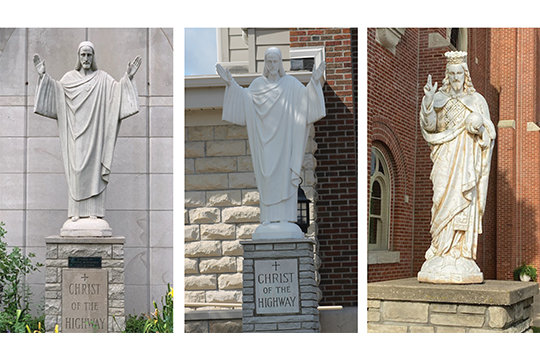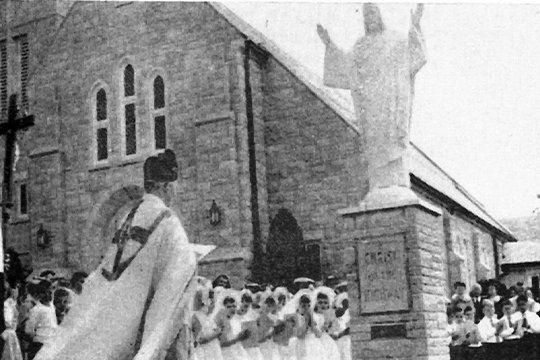Roadside images of Christ are enduring gifts of love
His way IS the highway!

This article was originally published in the Aug. 3, 2001, edition of The Catholic Missourian:
“Under the title of ‘Christ of the Highway,’ with hands extended in blessing, we ask Thee to bless and protect all travelers who journey through our land. And, since Thou hast said: ‘I am the Way and the Truth and the Life,’ we pray Thee also to guide, enlighten and sanctify all of us who travel the highway of life, so that our journey toward eternity may bring us safely home to Thee in heaven.”
Lifting up his voice and his eyes, the late Monsignor Gerold J. Kaiser splashed holy water onto the new “Christ of the Highway” statue on the front lawn of St. Patrick Church in Rolla.
It was Mother’s Day, May 12, 1957.
Msgr. Kaiser wore his papal chamberlain regalia. First communicants wore ties and veils. An image of Our Lady wore a crown of fresh flowers. And nearby U.S. 66 still wore the moniker of “Main Street of America.”
The Rolla Knights of Columbus had donated the new statue as part of the city’s centennial celebration.
The late Joe Loughridge, a longtime parishioner and Knight, had built the stone pedestal.
“Grant Thy abundant blessings to the people of this community in which we live,” Msgr. Kaiser prayed. “May this image of Thee be to all a vivid and frequent reminder of Thy definite promise to ‘be with us all days, even to the end of the world’ through Thy unfailing providence and loving care.”
It was to be the young Diocese of Jefferson City’s first “Christ of the Highway,” a tactile reminder of Christ’s abiding presence.
Its purpose was to invoke a blessing upon and express a warning to passing motorists on U.S. 63-66.
Two more such tableaus would appear along numbered highways in the diocese over the 10 years roughly paralleling the nation’s odyssey from fins to fastbacks.
Grateful parents
Shortly after Msgr. Kaiser was transferred to Immaculate Conception parish in Jefferson City in 1961, parishioners James and Irene Stegeman, who had been unable to have children, adopted a son.
“We decided that we had to give something back, to show our appreciation to God,” said Mr. Stegeman, who believes he’s had enough good luck for 10 people. “So we went to Msgr. Kaiser and talked a little about it. He told us he liked the ‘Christ of the Highway’ statue and said it worked really good in Rolla. He suggested that we do the same thing up here. Highway 50 came by the church back then.”
So Msgr. Kaiser and the Stegemans drove to Rolla to take a look.
“The minute we saw the statue, it really struck Irene and me in the heart,” Mr. Stegeman said. “We knew it was about the most perfect gift we could give. If anyone drove past the church and happened to say a prayer and then went down the road and got killed, that last thing on their mind could help them find their way to heaven.”
Encouraged by the Stegemans’ enthusiasm, Msgr. Kaiser ordered a practically identical statue.
Mr. Stegeman, a foundation-builder by trade, planned to make a red brick pedestal to match the church. “But then I thought it would stand out a little more if we used some Carthage limestone,” he said. “So I ordered some, and that’s what we used for the pedestal.”
Workers used a cherry picker to lift the statue into place.
Msgr. Kaiser blessed the statue on May 21, 1961, offering prayers that Christ would protect travelers and bring blessings to the community. The ceremony was held in connection with the parish’s May procession.
Third time’s the charm
Around 1967, a third “Christ of the Highway” statue appeared — this one outside Holy Family Church in Freeburg.
The late George Struemph, a Holy Family parishioner, was serving as executor of the estate of his brother, Raymond Struemph, who had died in St. Louis in 1965 or 1966.
Monsignor Bernard A. Timpe had just arrived in Freeburg as pastor. When George Struemph turned up some extra money in the estate and decided to donate it to the Church, Msgr. Timpe suggested “Christ of the Highway” in Raymond’s memory.
Parishioner Herb Stratman hired John Strope to build the pedestal with limestone from the old Jefferson City Stone Co.
Mr. Strope dug below the frost line and poured the concrete footings. He built the pedestal of concrete blocks and then faced it with limestone, capped with a flat slab for the statue.
Mr. Strope and several parishioners used a well truck and cable from the local MFA to lift the statue onto the pedestal. A half-inch-wide rod drilled into the pedestal would keep the statue from tipping over.
“Msgr. Tempe watched every move we made,” Mr. Stratman recalled. “I think he was worried we were going to break a hand off or something.”
The original statue fell off the pedestal when a motorist ran into it in 1970. The pedestal survived the impact, but the statue had to be replaced.
Another traffic accident in 1999 took the pedestal, along with the second statue, out of commission.
Insurance check in hand, the parish purchased a third statue and materials for a new pedestal.
Parishioners built a concrete infrastructure. Third-generation brick mason Isadore Forck, a member of St. Francis Xavier parish, Taos, who was doing brickwork at a home in Freeburg, agreed to lay the stone-mimicking concrete blocks facing all sides of the pedestal.
“Virgil Wieberg and Dan and Brent Stratman down there did the main work on it,” Mr. Forck said. “Inside the ‘stone,’ there are about 38 concrete blocks. I laid the stone around it. My part took about six hours. I had the time, and they’re really good people down there.”
Mr. Stratman kept telling Mr. Forck to send the parish a bill, but he never did.
“Finally, he called me and said, ‘I want to donate the time I spent doing that,’” Mr. Stratman said.
The new statue was placed atop the pedestal on July 5, 2000. Bathed in ivory light at night, it beckons passersby to reflect on what’s inside Freeburg’s magnificent “Cathedral of the Ozarks.”
“This time, if a car runs into it, it will do more damage to the car than the pedestal,” Mr. Stratman asserted.
From age to age
U.S. 66 through Rolla eventually was decommissioned when the Interstate 44 bypass was opened in the 1970s.
When St. Patrick Church was renovated and expanded in 1992, the original entrance fronting U.S. 63 was sealed up with stone, forming a Gothic-arched alcove. Parishioners decided to move “Christ of the Highway” from the corner of the churchyard to the alcove, which is now adorned with bushes and tulips that bloom majestically every spring.
The statue has been painted gray to match the stone backdrop. At night, dueling floodlights in front of the pedestal cast twin shadows onto the church, alluding to the depicted deity’s Trinitarian nature.
U.S. 50 through Jefferson City eventually was rerouted from East McCarty Street to the Rex M. Whitton Expressway. But East McCarty remains a vibrant “byway,” bustling with vehicular and pedestrian traffic.
At its intersection with Clark Avenue, a whitewashed sentry, arms outstretched, silently peers down from its 50-year-old pedestal.
“We hoped that one day our children would stand there and say their daddy and mommy gave it to the church,” Mr. Stegeman said.
Now, their grandchildren stand there and admire it, too.
Meg Poettgen, a member of Holy Family parish in Freeburg; and Clem Bruemmer, a member of St. Patrick parish in Rolla, helped research this article.
Comments
Other items that may interest you
Services
The Catholic
Missourian
2207 W. Main St.
Jefferson City MO 65109-0914
(573) 635-9127
editor@diojeffcity.org







